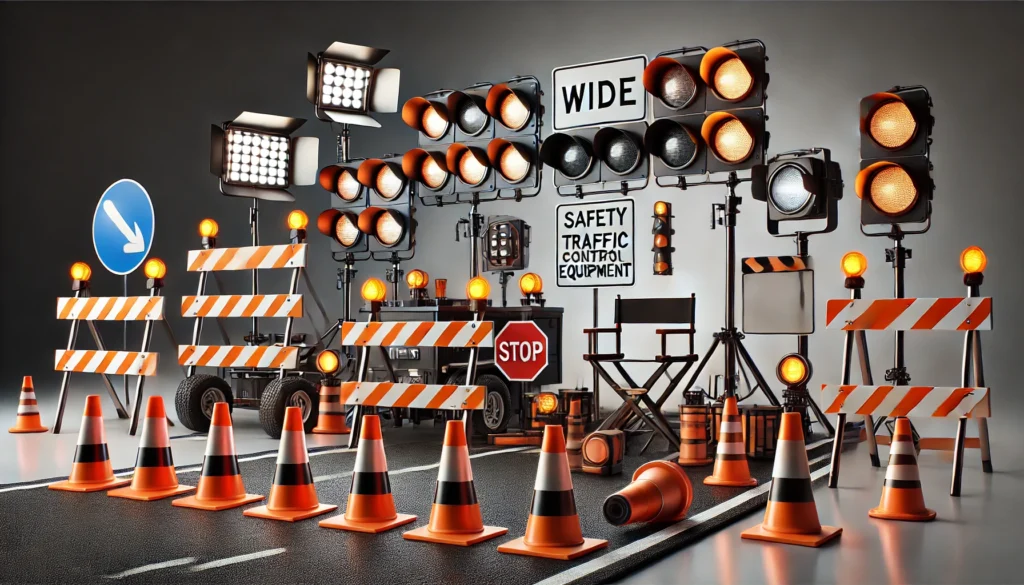Traffic barrier selection in an effective system plays a predominant role in guaranteeing safety of roads, work zones,the and events. This informative overview of barricades by Safety Network Inc. capitalizes on research and working examples across the industry and invites engineers, contractors, and safety managers to learn more about how to choose the right barrier for the right application.

1. Concrete Barriers (Jersey & F-Shape)
Expertise: One of the most robust permanent barriers are concrete barriers, which are commonly known as Jersey (screened top) or F-Shape (sloped legs).
- Use Cases:
- Medians & Dividers: Reduce cross median crashes on the highways.
- Work Zone Protections: Serve as a solid shield for crew against errant vehicles.
- Key Features:
- High Impact Resistance: Absorbs and redirects crash energy.
- Low Maintenance: Minimal long-term upkeep.
Authoritativeness: Caltrans and FHWA recognize them as standards for high speed applications (and also recognized for TL4 or TL5 crash tests).
2. Water-Filled Plastic Barriers
Expertise: When empty, they are lightweight HDPE barriers, but when used, those barriers contain ballast water or sand inside them.
- Use Cases:
- Temporary Lane Shifts: Road repairs or short-term events.
- Event Perimeters: Pedestrian protection at concerts or festivals.
- Key Features:
- Ease of Deployment: Towable and stackable before filling.
- Adjustable Weight: Control fill level for tuning impact performance.
Trustworthiness: That complies with ASTM F3016 criteria with the ability to be crash tested to TL-1/TL-2 when properly filled and anchored.
3. Steel Beam Guardrails (W-Beam & Thrie-Beam)
Expertise: They then mount corrugated beams on posts that let the beams flex and absorb crash energy.
- Use Cases:
- Rural Roads & Highways: Edge-of-road protection against roadside hazards.
- Transition Areas: Leading into concrete barrier systems.
- Key Features:
- Energy Dissipation: Beam deformation reduces occupant risk.
- Ease of Repair: Damaged sections can be replaced without full system overhaul.
Authoritativeness: Installed commonly per AASHTO’s Manual for Assessing Safety Hardware (MASH) at test levels TL-2 through TL-3.
4. Cable Barrier Systems
Expertise: String multiple tensioned steel cables between posts to catch and redirect vehicles.
- Use Cases:
- Medians on High-Speed Divided Highways: Reduces cross-over crash severity.
- Mountainous Terrain: Flexible system conforms to uneven grading.
- Key Features:
- Flexibility: Minimal vehicle rebound reduces secondary collisions.
- Cost-Effective Repairs: Post and cable replacement less expensive than concrete.
Trustworthiness: MASH TL-3 certified when properly installed with correct tensioning and end-terminal design.
5. Crash Cushions & Attenuators
Expertise: Energy-absorbing devices placed at fixed hazards (pole bases, T-intersections) or mounted on trucks (TMAs).
- Use Cases:
- Fixed Hazards: Shield bridge piers, sign supports, light poles.
- Mobile Protection: Truck-Mounted Attenuators (TMAs) for moving work zones.
- Key Features:
- Shock Absorption: Deform or crush in controlled sequence to dissipate crash energy.
- Multiple Ratings: TL-1 through TL-5 depending on speed and impact requirements.
Authoritativeness: Widely mandated by Caltrans for work-zone end treatments and known to save lives by reducing injury severity.
6. Portable Plastic Barriers (Type I-III Barricades)
Expertise: A-frame barricades and channelizers—lightweight, highly visible devices for short-term control.
- Use Cases:
- Pedestrian Detours: Sidewalk closures and sidewalk work areas.
- Low-Speed Work Zones: Shoulder or curbside maintenance.
- Key Features:
- High Visibility: Reflective sheeting options.
- Stackable Storage: Easy transport and staging.
Trustworthiness: Compliant with CA MUTCD Section 6F for temporary traffic control devices; ideal for short-duration tasks.
Best Practices for Barrier Selection
- Match Barrier to Design Speed & Traffic Volume
- High-speed roadways require MASH crash-tested barriers (TL-3+).
- Low-speed or low-volume areas can use cable or portable barriers.
- Consider Install & Maintenance Logistics
- Permanent jobs favor concrete or steel systems.
- Temporary or evolving sites benefit from water-filled or portable devices.
- Verify Regulatory Compliance
- Check Caltrans specifications (Standard Plans and Specifications Book) for work-zone barrier requirements.
- Ensure devices carry relevant crash-test certifications (AASHTO/MASH, ASTM).
- Plan for End Treatment & Transitions
- Use crash cushions or ramped terminals at barrier ends.
- Transition between barrier types seamlessly to maintain continuous protection.
Frequently Asked Questions (FAQs)
Q: What barrier type is best for a high-speed highway median?
A: Median cable barriers (TL-3) or concrete Jersey barriers (TL-4/TL-5) offer optimal cross-median protection at speeds above 50 mph.
Q: Can water-filled barriers be reused?
A: Yes. Simply drain, transport, and refill. Proper cleaning between uses extends service life.
Q: How often should steel guardrails be inspected?
A: Inspect quarterly for corrosion, damaged posts, and loose connections. Prompt repair maintains crash performance.
Q: Are portable plastic barriers effective at night?
A: When equipped with reflective sheeting or lights, they provide excellent nighttime visibility for low-speed zones.
Q: What’s the difference between TMAs and fixed crash cushions?
A: TMAs are mobile attenuators mounted on trucks for moving work zones, while crash cushions are stationary units protecting fixed hazards.
Conclusion
Selecting the right traffic barrier involves balancing speed, risk, permanence, and budget. Safety Network Inc. combines deep industry expertise and a comprehensive product portfolio to guide you from planning to deployment—ensuring your site meets rigorous safety standards and protects both road users and workers.
For personalized consultation or to explore our full range of traffic barrier solutions, visit SafetyNetworkInc.com or contact our experts.

